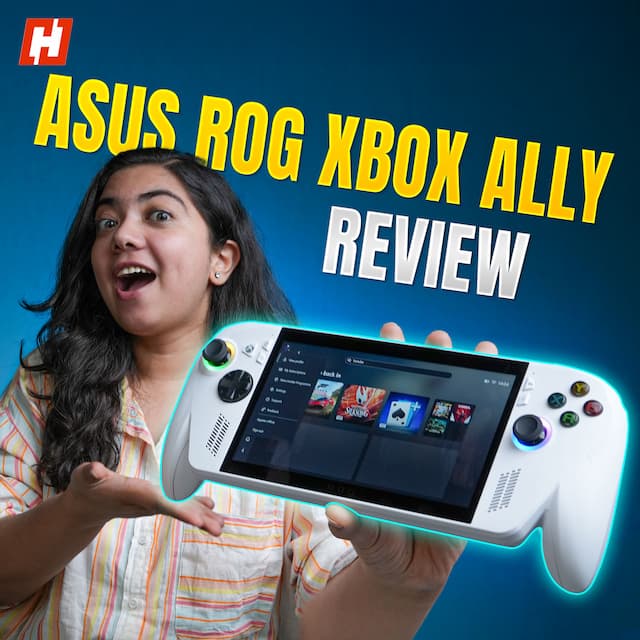Asus ROG Xbox Ally review: Portable gaming done right

| Key Category | Specifications |
| Processor | AMD Ryzen Z2 A Processor |
| Display | 7-inch FHD IPS Panel @ 120Hz |
| RAM + Storage | 16GB LPDDR5 + 512GB NVME SSD |
| Battery + Charging | 60Wh + 65W |
- Xbox-style grips makes long gaming sessions comfortable.
- Smooth vibrant and responsive display
- Solid set of front-facing speakers
- Solid performance in 720P
- Rear macro buttons
- Works well with existing Xbox and PC game libraries
- Battery life can be very impressive
- Trimmed down Windows 11 with Full Screen Xbox experience
- Switching between the Xbox interface and regular Windows can be jarring
- No hall-effect joy sticks at this price
- Display's brightness a little low
- Priced slightly higher than it's worth
Handheld gaming has been quietly making a comeback, and the Asus ROG Xbox Ally fits right into that moment. It’s very clear about what it wants to be. It’s not here to replace your main gaming desktop or console, and it’s not trying to flex as the most powerful handheld out there. Instead, it focuses on making gaming easier to carry around, more comfortable to hold, and honestly, just more enjoyable. And in most ways, it manages to pull that off.
Now, Microsoft may be positioning this as an “Xbox you can take anywhere,” but I don’t quite buy that. At its core, this is a Windows handheld, one that simply makes it easier to tap into your PC and Xbox game library. And the design choices show a lot of thought, especially in the way it feels in your hands and how the hardware has been put together.
It isn’t flawless. No handheld really is. But it has enough strengths to deserve attention, especially if you’re someone who likes to game while travelling, commuting, or just not being tied to a desk.
ROG Xbox Ally's Design
The first thing that stood out to me about the ROG Xbox Ally is just how natural it feels in the hands. Those Xbox-style grips instantly click. If you’ve ever held a Microsoft controller, your fingers just fall into place without any thought. The curved handles let your fingers rest comfortably, and even after longer play sessions, I didn’t get that cramped, claw-grip fatigue you often feel with handhelds. The slightly forward-tilted display also makes more of a difference than I expected. After a couple of hours, I realised my wrists were way more relaxed than usual.
The control layout sticks closely to the familiar Xbox setup: ABXY buttons, triggers, D-pad, and two analogue sticks. The buttons have a satisfying click, and the hall-effect triggers are smooth and precise, which you really notice in shooters or racing games. It’s a small letdown that the thumbsticks don’t use hall-effect sensors, because at this price point, that would’ve been the more durable and future-proof choice. The two rear macro buttons, though, are genuinely handy once you map them to your most-used actions, and the haptics feel more refined than I've seen in most handhelds.
Because it’s an ROG device, yes, there’s RGB. But it’s understated: not the whole discotheque-on-your-desk vibe, and you can customise it through Armoury Crate. What really surprised me, though, were the speakers. They’re front-facing, surprisingly loud, and noticeably clearer than the speakers on quite a few mid-range gaming laptops. Dolby Atmos adds a nice boost when you're using headphones, and the built-in mic is perfectly fine for casual voice chat.
For connectivity, you’ve got the essentials: a 3.5mm headphone jack, two USB-C ports with DisplayPort support, and a microSD slot. And yes, if you want to go full portable-PC mode, you can dock it, connect a monitor, and use it like a tiny desktop setup.
ROG Xbox Ally's Display
The ROG Xbox Ally comes with a 7-inch Full HD IPS display running at 120Hz, and in everyday use, it feels like a good fit for a handheld. The screen is big enough to feel immersive, but not so large that it becomes awkward to hold. Sure, it would’ve been great to have an OLED panel here. I won’t pretend I didn’t think about that, but honestly, after a few hours of play, I didn’t really miss it as much as I thought I would.
At this size, the 1080p resolution looks sharp, and that high refresh rate makes everything feel smooth, from scrolling through menus to fast-paced in-game motion. I was pleasantly surprised by the colour handling as well. With full sRGB and strong Adobe RGB coverage, the display hits a nice balance: colours look lively without being blown out, and darker scenes show good separation instead of muddy greys.
Indoor brightness is perfectly fine, though the glossy finish can be a bit reflective if you’re sitting near a bright window or trying to play outside. It’s not a dealbreaker, just something you notice. On the upside, Gorilla Glass Victus does add some confidence when throwing it into a bag or carrying it around regularly.
What impressed me most, though, is how well the screen handles motion. The 120Hz refresh rate paired with FreeSync Premium just gives a smooth experience. The overall experience still feels smooth and controlled, instead of choppy or jittery. It makes a noticeable difference during fast action sequences.
Performance & Gaming on the ROG Xbox Ally
The ROG Xbox Ally runs on AMD’s Ryzen Z2 APU, which uses older Zen 2 CPU cores paired with RDNA 2 graphics. On paper, that specification does not sound particularly impressive, and I went in with fairly moderate expectations.
This is not a device that is aiming to replace a gaming laptop. Once I actually started playing, though, the performance felt noticeably better than what the specs would lead you to believe. A lot of that comes down to smart tuning and the fact that the display resolution is well-suited to what the APU can comfortably handle.
You get 16GB of LPDDR5 RAM and a 512GB PCIe 4.0 SSD. In theory, that should mean fast load times, but in reality, some heavier AAA titles took longer to start than I would have preferred. Lighter games, indie titles, and older releases ran without any hesitation. Once a game is running, even the demanding ones, the system feels responsive and stable.
At 1080p with medium to low settings, most modern games are not just playable but actually enjoyable in a way that feels close to a console experience. Dropping the resolution to 720p gives you a noticeable performance boost, and on a 7-inch screen, the reduction in sharpness is barely noticeable during actual gameplay.
Forza Horizon 5, for example, feels smooth, colourful, and easy to play for long stretches. Even something more demanding like Black Myth: Wukong performs better than expected as long as you keep your settings sensible and do not try to push everything to ultra.
The overall takeaway is simple. If you are willing to adjust your settings rather than maxing them out, the Ally delivers consistent and reliable performance. It is built for handheld play, and when used with that mindset, it performs really well.
ROG Xbox Ally's Software & UI
The software side of the ROG Xbox Ally actually surprised me more than I expected. When you power it on, it boots into a full-screen Xbox-style interface instead of the standard Windows desktop. That alone changes the feel of the device. It comes across like a dedicated handheld gaming machine rather than a small Windows laptop with controllers attached.
Once you have the Xbox environment set up properly, you almost forget that Windows is still running underneath. In day-to-day use, the Ally genuinely behaves like a handheld console. That illusion holds together nicely until you start using anything outside the Xbox ecosystem. The moment you open Steam, Epic Games Launcher or Ubisoft Connect, the familiar login windows, pop-ups, background services, and the occasional error window remind you that this is still a Windows machine at heart.
There is also a bit of juggling involved when switching between interfaces. Holding the Xbox button brings up a window that shows all open apps and also gives you the option to switch to the Windows desktop and use the device like a regular PC. That works fine, but switching back to the full-screen Xbox interface is trickier. If you try to return without restarting, performance can dip and the experience becomes noticeably less smooth. Restarting fixes it, but it breaks the flow.
So the pattern is pretty clear. When everything is launched from the Xbox library, the experience is clean and friction-free. When you step outside that bubble, things can get messy.
One part of the software I genuinely liked is Armoury Crate. It is integrated well and I found myself using it all the time. It lets you manage performance modes, tweak lighting, adjust resolution, and set frame rate caps for individual games. The interface is easy to get to while playing, which makes it useful when you are trying to strike the right balance between performance, battery life, and heat.
Battery life on the ROG Xbox Ally
Battery life on the ROG Xbox Ally really depends on what you are playing and which performance mode you are using. The 60Wh battery is fairly generous for a handheld of this size, and when I stuck to lighter indie games or titles that are not too GPU heavy, I was able to get a comfortable amount of playtime on a single charge.
Once you move to something more demanding, like Black Myth: Wukong, battery life does drop quite a bit. In those cases, I was getting around an hour and a half of gameplay, which is more or less what I expected given the hardware and the performance levels involved.
In my own testing with Skillsong, I saw roughly a 20 percent drop in battery over the course of an hour, which lines up with the overall pattern. Using Bluetooth headphones, higher brightness levels, or keeping the RGB lighting on will naturally drain the battery faster.
The 65W fast charger helps keep things manageable. A quick break plugged into the wall is often enough to get you back into your game. It is not a device you are going to game on all day without charging, but with a bit of performance tuning and reasonable expectations, the battery life is workable and easy to live with.
Verdict: Should you buy the Asus ROG Xbox Ally?
At ₹69,990, what you are paying for, is the freedom to play wherever you happen to be, and for that, it is a bit expensive. The ROG Xbox Ally works best when you stop thinking of it as a replacement for your main gaming machine.
It is more like a companion device. Something you pick up on the sofa, on a flight, or at a café, and just continue the games you already love playing.
If your goal is raw performance, a proper gaming laptop or desktop will obviously do a much better job. And if you are trying to stay under a tighter budget, the Steam Deck still offers great value, even if its hardware is clearly ageing now.
Where the Ally shines is in how pleasant it is to use. It feels good in the hands. The screen looks sharp and lively. The speakers are surprisingly loud and clean. And once you dial in your settings, the performance feels stable enough that you simply settle into your game and forget about the hardware.
It is not perfect. But it is the kind of device that encourages you to keep playing, simply because the experience feels smooth and familiar.



